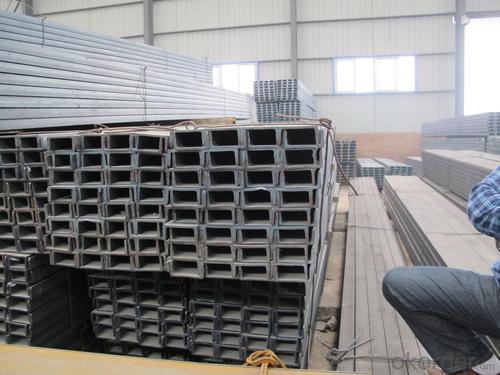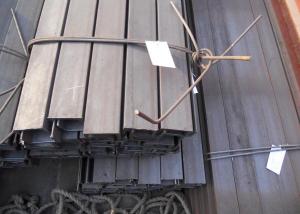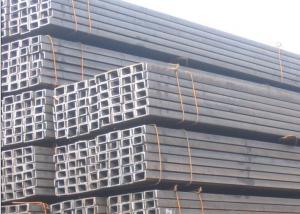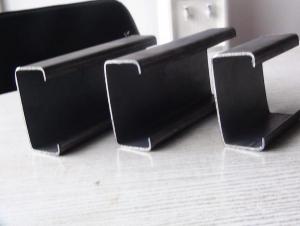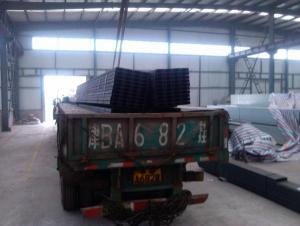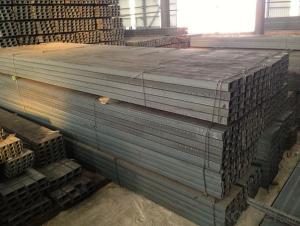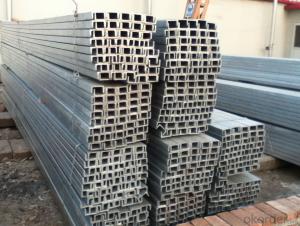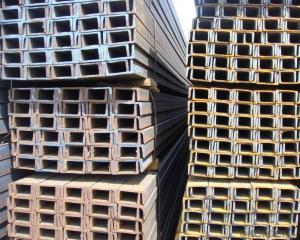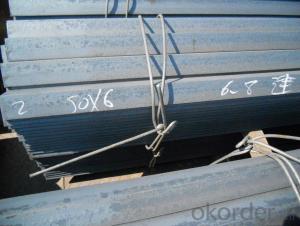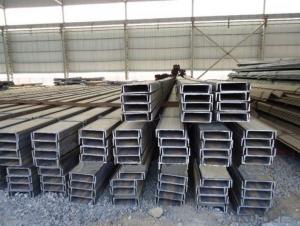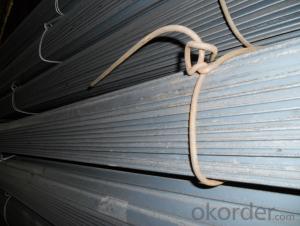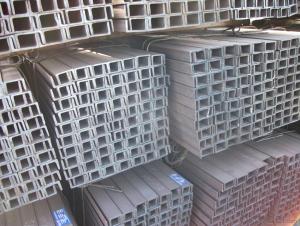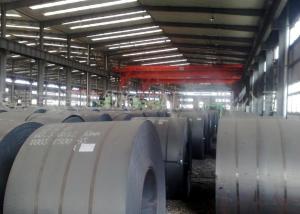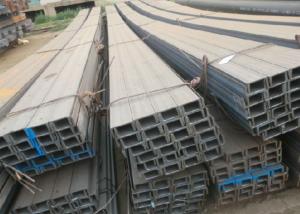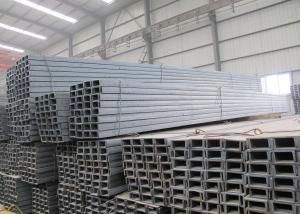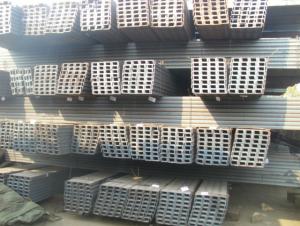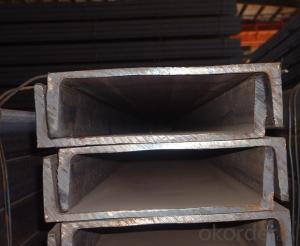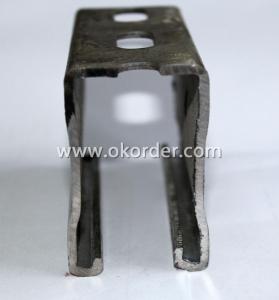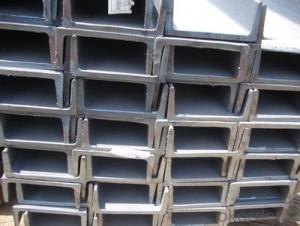Hot Rolled Channel Carbon Steel Hign Quality
- Loading Port:
- China Main Port
- Payment Terms:
- TT or LC
- Min Order Qty:
- -
- Supply Capability:
- -
OKorder Service Pledge
OKorder Financial Service
You Might Also Like
Product Description:
OKorder is offering STEEL CHANNEL at great prices with worldwide shipping. Our supplier is a world-class manufacturer of steel, with our products utilized the world over. OKorder annually supplies products to European, North American and Asian markets. We provide quotations within 24 hours of receiving an inquiry and guarantee competitive prices.
Product Applications:
1.The JIS channel can be devided into two kinds, namely common channel steel and light channel steel. The sizes of hot rolled common channel steel range from 5# to 40#. Meanwhile, the channel steel can be divided into cold forming sectional equal channel steel, cold forming sectional unequal channel steel, cold forming inner edge channel steel and outer edge channel steel.
2.The JIS channel is usually used for arch-itechtural structure, and they could be welded in order to support or hang a vari-ety of facilities. They are also usually used in combination with I beam. The channel steel with sizes under 14# is usually applied to construction engineering, as purline, while the channel steel with sizes above 16# is more likely to be used in building vehicle chassis structure and mechanical structure. Furthermore, the channel steel in sizes above 30# are target at building bridge structure, as tension bar.
3.In a word, the channel steel must possess perfect welding property, riveting property and mechanical property and so on.
Product Advantages:
OKorder's STEEL CHANNELare durable, strong, and resist corrosion.
Main Product Features:
· Premium quality
· Prompt delivery & seaworthy packing (30 days after receiving deposit)
· Corrosion resistance
· Can be recycled and reused
· Mill test certification
· Professional Service
· Competitive pricing
Product Specifications:
Standard | GB/JIS |
Material Grade | Q235,SS400 |
Technique: | Hot Rolled |
Sizes as per chinese standard: | 50*37*4.5mm - 300*89*11.5mm |
Sizes as per japanese standard: | 50*25*3mm – 200*80*7.5mm |
Length: | 6meter, 9meter, 12meter |
Note: 1.we are also competent to provide our customers other MS Channel based on other sizes according to customer’s requirements.
2. The length of our ms channel could be cut into other meters as per customer’s requirements. For example, the channel in 6meters could be cut into 5.8meters in order to be fit in the 20ft container.
GB U CHANNEL | Standard | Sectional | Dimension |
| Mass: |
| (mm) | (mm) | (mm) | (mm) |
|
50X37 | 50 | 37 | 4.50 | 7.0 | 5.438 |
63X40 | 63 | 40 | 4.80 | 7.5 | 6.634 |
80x43 | 80 | 43 | 5.00 | 8.0 | 8.045 |
|
|
|
|
|
|
100x48 | 100 | 48 | 5.30 | 8.5 | 10.007 |
120x53 | 120 | 53 | 5.50 | 9.0 | 12.059 |
140x58 | 140 | 58 | 6.00 | 9.5 | 14.535 |
140x60 | 140 | 60 | 8.00 | 9.5 | 16.733 |
|
|
|
|
|
|
160x63 | 160 | 63 | 6.50 | 10.0 | 17.240 |
160x65 | 160 | 65 | 8.50 | 10.0 | 19.752 |
|
|
|
|
|
|
180x68 | 180 | 68 | 7.00 | 10.5 | 20.174 |
180x70 | 180 | 70 | 9.00 | 10.5 | 23.000 |
|
|
|
|
|
|
200x73 | 200 | 73 | 7.00 | 11.0 | 22.637 |
200x75 | 200 | 75 | 9.00 | 11.0 | 25.777 |
|
|
|
|
|
|
220x77 | 220 | 77 | 7.00 | 11.5 | 24.999 |
220x79 | 220 | 79 | 9.00 | 11.5 | 28.453 |
|
|
|
|
|
|
250x78 | 250 | 78 | 7.00 | 12.0 | 27.410 |
250x80 | 250 | 80 | 9.00 | 12.0 | 31.335 |
250x82 | 250 | 82 | 11.00 | 12.0 | 35.260 |
|
|
|
|
| |
280x82 | 280 | 82 | 7.50 | 12.5 | 31.427 |
280x84 | 280 | 84 | 9.50 | 12.5 | 35.823 |
280x86 | 280 | 86 | 11.50 | 12.5 | 40.219 |
|
|
|
|
|
|
300x85 | 300 | 85 | 7.50 | 13.5 | 34.463 |
300x87 | 300 | 87 | 9.50 | 13.5 | 39.173 |
300x89 | 300 | 89 | 11.50 | 13.5 | 43.883 |
Alloy No | Grade | Element(%) | ||||
C | Mn | S | P | Si | ||
Q235 | B | 0.12-0.20 | 0.3-0.7 | ≦0.045 | ≦0.045 | ≦0.3 |
Note: we are able to present our customers relevant SGS test report for mechanical property of MS Channel as customer’s request.
Package & Delivery of MS Channel:1.The hot rolled channel steel will be packed in bundle with steel wire at each end of every bundle and color marking in order to help the customer to recognize his goods more easily at sight.
2. And the hot rolled channel steel could be loaded into 20ft or 40ft container, or by bulk cargo.If the weight of each bundle reaches more than 3.5 mt, the loading by break bulk cargo should be choosed.When the weight of each bundle reaches less than 3mt, the loading by container should be choosed.
3.As for the transportaion from mill to loading port, the truck will be usually used. And the maximum quantity for each truck is 40mt.
4.All in all, we could do in accordance with customer's request.
FAQ:
Q1: Why buy Materials & Equipment from OKorder.com?
A1: All products offered byOKorder.com are carefully selected from China's most reliable manufacturing enterprises. Through its ISO certifications, OKorder.com adheres to the highest standards and a commitment to supply chain safety and customer satisfaction.
Q2: How do we guarantee the quality of our products?
A2: We have established an advanced quality management system which conducts strict quality tests at every step, from raw materials to the final product. At the same time, we provide extensive follow-up service assurances as required.
Q3: What makes stainless steel stainless?
A3: Stainless steel must contain at least 10.5 % chromium. It is this element that reacts with the oxygen in the air to form a complex chrome-oxide surface layer that is invisible but strong enough to prevent further oxygen from "staining" (rusting) the surface. Higher levels of chromium and the addition of other alloying elements such as nickel and molybdenum enhance this surface layer and improve the corrosion resistance of the stainless material.
Images:
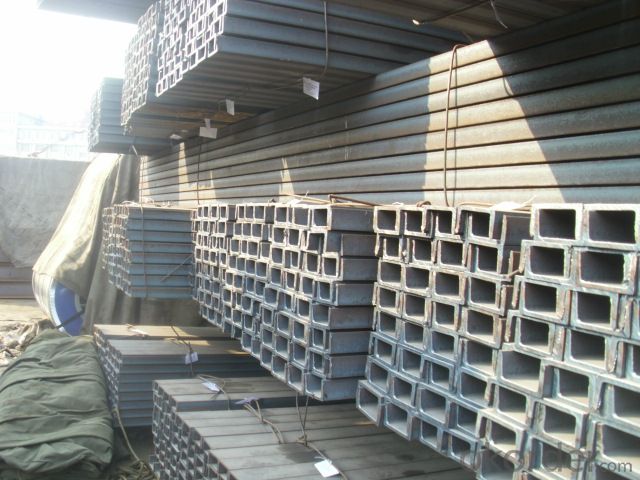
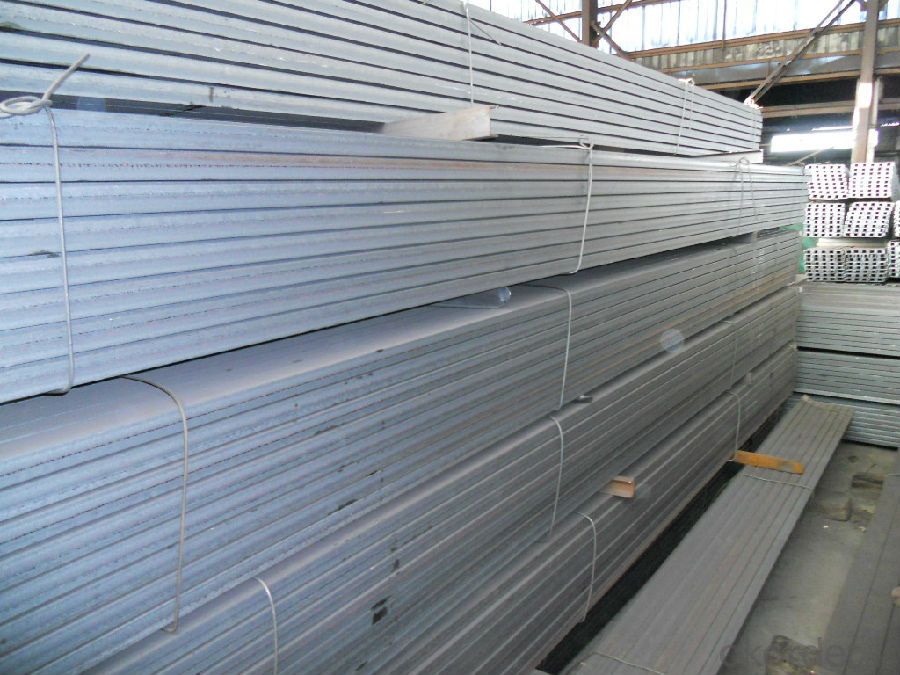
- Q: Can steel channels be used for solar panel mounting?
- Indeed, steel channels have the ability to be utilized for the purpose of mounting solar panels. Opting for steel channels as a mounting solution not only offers robustness and longevity, but also the capacity to bear the weight of the panels and withstand diverse weather conditions. Moreover, steel channels can be effortlessly tailored and adapted to meet the precise demands of the solar panel installation. They furnish a dependable base for the panels, allowing for installation on rooftops, ground mounts, or other structures. Nevertheless, it is crucial to guarantee the proper installation and anchoring of the steel channels to ensure the requisite stability for the solar panels.
- Q: Are steel channels suitable for use in storage racks?
- Steel channels are indeed suitable for use in storage racks. Their design is intended to provide structural support and strength, making them an excellent choice for storing heavy items or materials on racks. They possess a high load-bearing capacity, durability, and resistance to bending or warping, all of which contribute to the stability and safety of the storage racks. Additionally, steel channels can be easily customized and adjusted to meet specific storage requirements, making them a versatile option for various storage applications. In conclusion, steel channels are a dependable and effective choice for constructing storage racks.
- Q: Can steel channels be used in electrical applications?
- Yes, steel channels can be used in electrical applications. Steel channels are often used in electrical installations to provide support and protection for electrical cables and wiring. They are commonly used in industrial and commercial settings where durability and strength are important. Steel channels are typically made from galvanized steel, which provides corrosion resistance and ensures a long lifespan. They can be easily installed and provide a stable and secure pathway for electrical cables, helping to prevent damage and maintain a neat and organized wiring system. Additionally, steel channels can be used to mount electrical equipment and components, such as junction boxes or conduits, allowing for easy access and maintenance. Overall, steel channels are a reliable and versatile option for electrical applications.
- Q: Are steel channels suitable for soundproofing purposes?
- No, steel channels are not suitable for soundproofing purposes as they are not effective in reducing or blocking sound transmission.
- Q: Are steel channels cost-effective compared to other materials?
- Yes, steel channels are generally considered cost-effective compared to other materials. Steel is a durable and versatile material that offers high strength-to-weight ratio, making it efficient in structural applications. Additionally, steel channels are readily available in various sizes and shapes, allowing for easy customization and reduced waste. While the initial cost of steel may be slightly higher than some other materials, its long lifespan, low maintenance requirements, and recyclability contribute to its overall cost-effectiveness in the long run.
- Q: What are the different corrosion protection methods for steel channels in marine environments?
- There are several corrosion protection methods available for steel channels in marine environments. These methods are crucial as marine environments are highly corrosive due to the presence of saltwater and other harsh elements. Some of the commonly used corrosion protection methods for steel channels in marine environments include: 1. Coating: Applying protective coatings is one of the most effective methods to prevent corrosion in marine environments. Coatings such as epoxy, polyurethane, and zinc-rich paints provide a barrier between the steel surface and the corrosive elements, preventing direct contact and subsequent corrosion. 2. Cathodic protection: This method involves the use of sacrificial anodes or impressed current to protect steel channels from corrosion. Sacrificial anodes, typically made of zinc or aluminum, are attached to the steel channels and corrode preferentially, sacrificing themselves to protect the steel. Impressed current systems use an external power source to provide a protective electrical current to the steel channels. 3. Galvanization: Galvanizing steel channels involves coating them with a layer of zinc. This process provides a sacrificial layer that corrodes instead of the steel, thus protecting it from corrosion. Galvanization is often used in marine environments where steel channels are exposed to saltwater and other corrosive agents. 4. Stainless steel: Using stainless steel channels is another effective corrosion protection method. Stainless steel contains a significant amount of chromium, which forms a passive oxide layer on the surface that protects against corrosion. This material is highly resistant to corrosion in marine environments and is often used in critical applications. 5. Proper maintenance: Regular inspection and maintenance of steel channels in marine environments are essential to prevent corrosion. This includes removing any marine growth, repairing any coating damage, and ensuring proper drainage and ventilation to minimize the exposure to corrosive elements. It is important to note that the selection of the corrosion protection method depends on factors such as the severity of the marine environment, the duration of exposure, and the expected lifespan of the steel channels. Consulting with corrosion engineers or specialists can help determine the most suitable protection method for specific marine applications.
- Q: Is it better to cast a pipe or a channel steel?
- The deadweight of concrete is too large to be calculated in tons. If the span is too large, with a reinforced concrete beam reinforced swing down from the middle, on both sides is the main force, the deformation of beam steel tension, resulting in bearing wall deformation.
- Q: What are the applications of steel channels in construction?
- Due to their strength, durability, and versatility, steel channels are widely used in construction for a variety of purposes. The following are some key applications of steel channels in construction: 1. Structural Support: Steel channels are commonly employed to provide structural support in buildings, bridges, and other infrastructure projects. They can be utilized as beams or columns to effectively carry loads and distribute weight. 2. Framing: Steel channels are frequently utilized in framing applications, particularly for walls, ceilings, and roofs. They offer a robust and dependable framework that ensures the stability and integrity of the structure. 3. Staircases and Handrails: Steel channels are an ideal choice for constructing staircases and handrails due to their strength and rigidity. They provide a safe and durable solution, especially in areas with high foot traffic. 4. Reinforcement: Steel channels can be used to reinforce concrete structures, such as foundations, walls, and slabs. By incorporating steel channels, the strength and load-bearing capacity of the concrete are significantly enhanced. 5. Mezzanine Floors: Steel channels are commonly used to create mezzanine floors, which provide additional space in buildings without the need to expand the footprint. Steel channels offer a lightweight yet sturdy solution for supporting the floor structure. 6. Industrial Racks and Shelves: Steel channels are extensively used in the construction of industrial racks and shelves. Their ability to bear heavy loads and their durability make them suitable for storing heavy equipment, materials, and products. 7. Infrastructure Projects: Steel channels find widespread applications in large-scale infrastructure projects, including bridges, tunnels, and railways. Their high strength-to-weight ratio makes them ideal for withstanding heavy loads and resisting environmental factors. 8. Architectural Design: Steel channels are commonly employed in architectural design to create unique and aesthetically pleasing structures. They can be shaped and welded into various configurations, allowing architects to bring their creative visions to life. Overall, steel channels are of utmost importance in the construction industry, providing a dependable, durable, and versatile solution for various applications. Their strength, load-bearing capacity, and flexibility make them indispensable in modern construction projects.
- Q: Can steel channels be used for platform stairs?
- Yes, steel channels can be used for platform stairs. Steel channels are often used in construction for their strength and durability. They provide excellent structural support, making them suitable for stairs and platforms, especially in industrial or commercial settings where heavy loads and frequent use are expected. Steel channels can be easily fabricated and welded to create a sturdy and reliable staircase. Additionally, they can be customized to meet specific design requirements, such as the desired height, width, and angle of the stairs. Overall, steel channels are a popular choice for platform stairs due to their strength, versatility, and ability to withstand heavy foot traffic.
- Q: Can steel channels be used for supporting HVAC systems?
- Yes, steel channels can be used for supporting HVAC systems. Steel channels are typically made of durable and strong steel material, making them suitable for providing structural support to HVAC equipment. They are often used in conjunction with other support materials, such as brackets and hangers, to securely hold and suspend HVAC units, ductwork, and piping. Steel channels offer several advantages for supporting HVAC systems. Firstly, they have high load-bearing capacity, ensuring that the weight of the HVAC equipment and components is adequately supported. Additionally, steel channels are resistant to corrosion and can withstand harsh environmental conditions, making them suitable for both indoor and outdoor applications. Steel channels also provide flexibility in terms of installation. They can be easily adjusted and customized to accommodate different HVAC system configurations. Moreover, steel channels can be installed using various methods, such as welding, bolting, or clamping, offering versatility in the installation process. It is important to ensure that the steel channels used for supporting HVAC systems are designed and installed according to industry standards and local building codes. Proper engineering and design considerations, including load calculations, seismic requirements, and thermal expansion, should be taken into account to ensure the safety and stability of the HVAC system. Overall, steel channels are a reliable and commonly used method for supporting HVAC systems, providing strength, durability, and flexibility in installation.
Send your message to us
Hot Rolled Channel Carbon Steel Hign Quality
- Loading Port:
- China Main Port
- Payment Terms:
- TT or LC
- Min Order Qty:
- -
- Supply Capability:
- -
OKorder Service Pledge
OKorder Financial Service
Similar products
Hot products
Hot Searches
Related keywords



